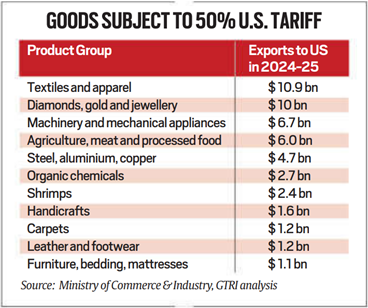

27th August 2025 (18 Topics)
Context:
The U.S. has imposed a 50% tariff on select Indian exports, effective from August 27, 2025, severely affecting low-margin sectors like textiles, gems, and jewellery.
Tariff Details:
- The U.S. has imposed a 50% tariff on 20% of India’s merchandise exports, including textiles, apparel, gems, jewellery, carpets, furniture, and shrimps.
- This follows a prior 25% tariff announced in July 2025, with the additional 25% acting as a “penalty” linked to New Delhi’s purchases of Russian oil and other imports from Moscow.
Impact on Indian Exports:
- Exports to the U.S. from India could decline by 40–45% in FY26 compared to FY25.
- Key affected sectors by value include textiles and apparel ($10.9 bn), gems, gold, and jewellery ($10 bn), machinery and mechanical appliances ($6.7 bn), and agriculture/meat/processed food ($6 bn).
- Sectors like pharmaceuticals, electronics, and petroleum remain exempt. Auto parts (4% of exports) face a 25% tariff.
Geographical and Sectoral Effects:
- Textiles:Tiruppur, Ludhiana, Jaipur, Noida–Gurugram clusters; major buyers may shift to Bangladesh, Vietnam, Mexico, and Costa Rica.
- Gems and jewellery: Surat, Mumbai, Jaipur; competitors include Israel, Belgium, China, and Mexico.
- Carpets:Bhadohi, Mirzapur, and Srinagar; potential gainers include Turkey, Pakistan, and Nepal.
- Handicrafts: Jodhpur, Jaipur, Moradabad; potential gainers include Vietnam, China, Turkey, and Mexico.

Economic Implications:
- Low-skilled jobs in affected sectors face jeopardy, with estimates of nearly 30% of U.S.-bound exports at risk.
- The tariffs may make Indian exports uncompetitive, leading to shifts in global supply chains.
- Crisis ratings and economic predictions indicate reduced revenues and employment in export-oriented sectors.
Global Trade Dynamics:
- S. competitors like Vietnam, Bangladesh, and China could benefit from the shift.
- Tariff strategy reflects geopolitical and economic leverage, influencing India-U.S. trade negotiations.
More Articles

